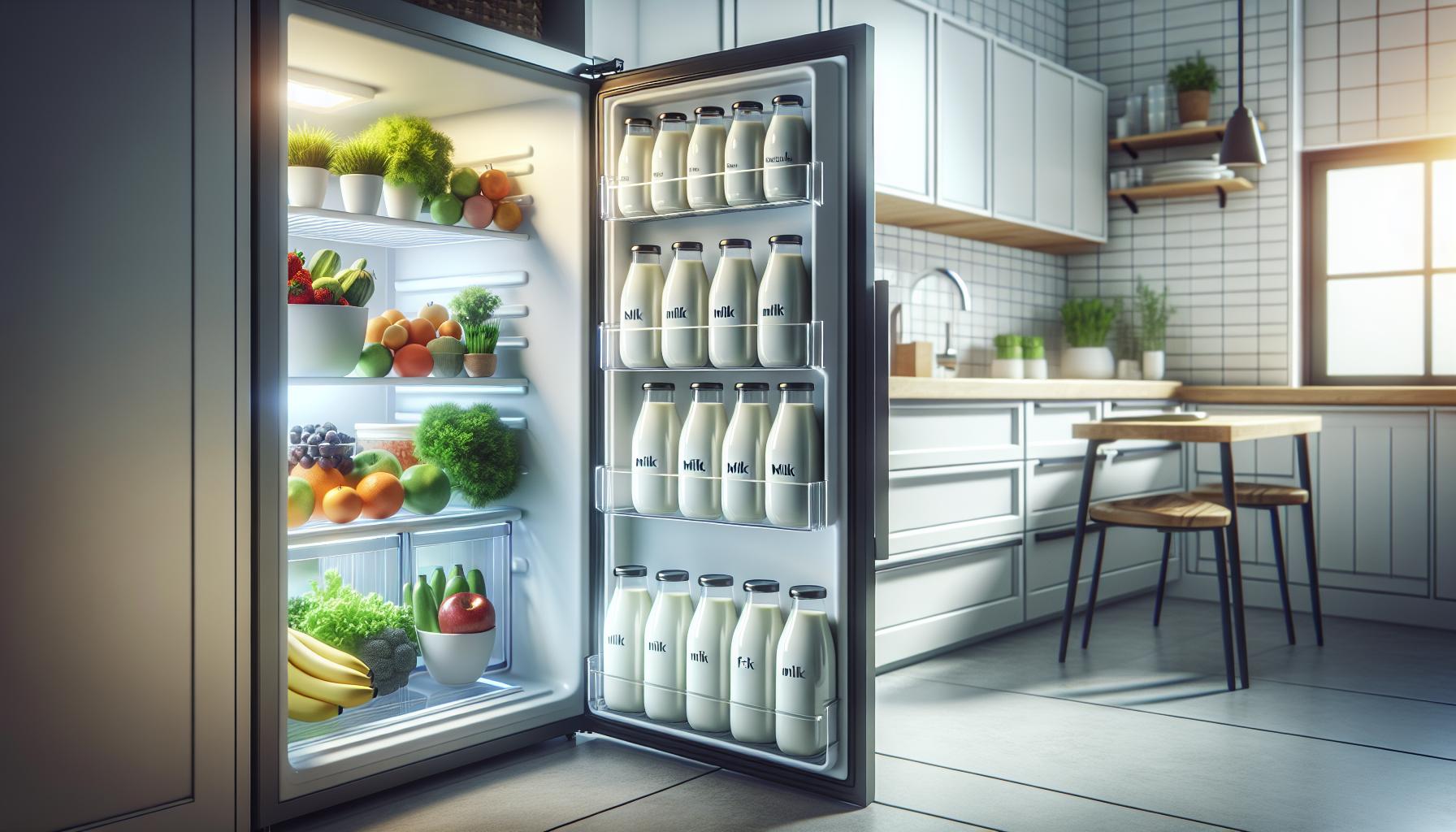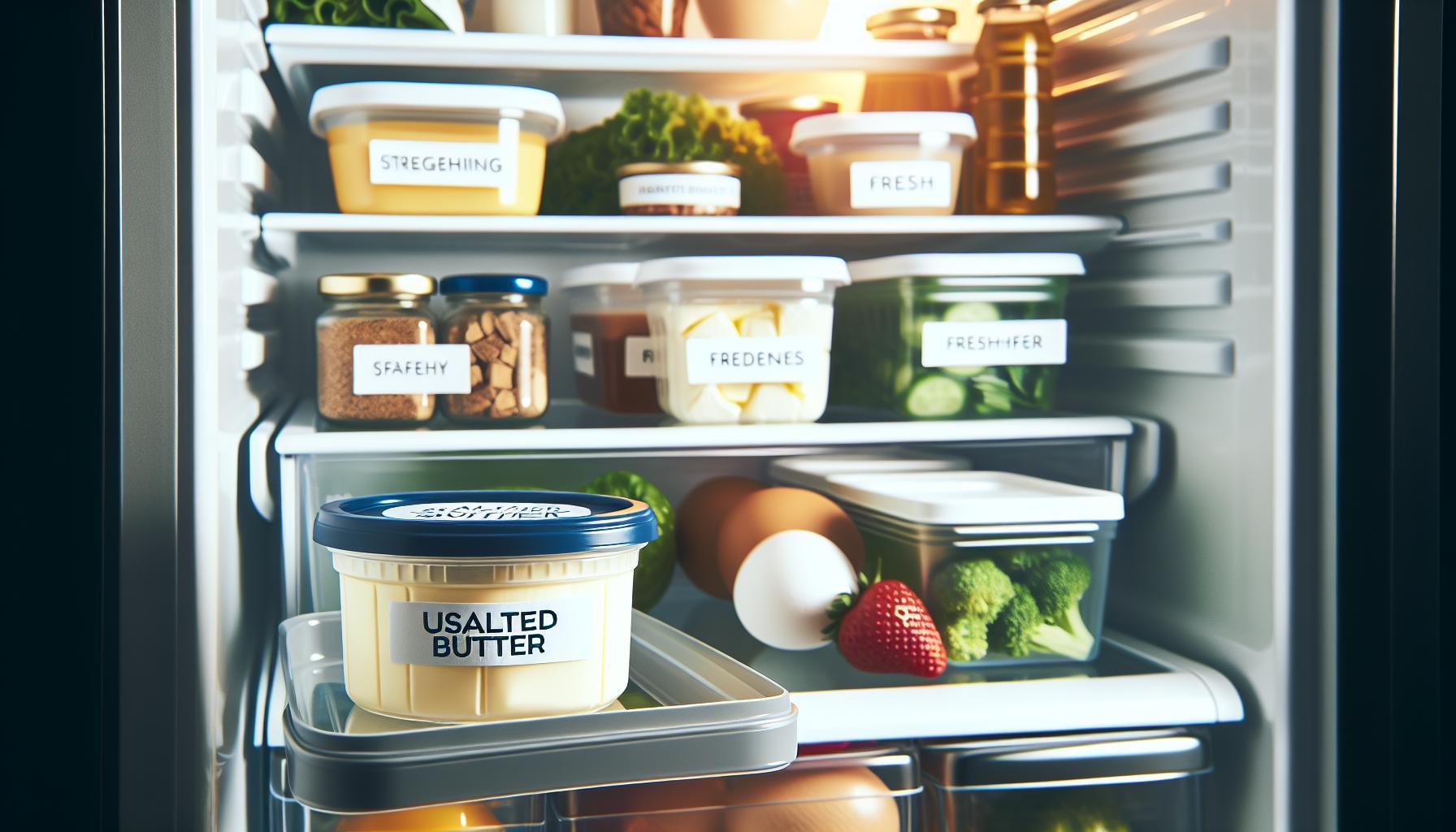Milk is a staple in many households, prized for its versatility and nutritional benefits. However, knowing how long milk lasts in the fridge is crucial for both safety and reducing waste. Did you know that up to 25% of milk is discarded due to spoilage? This not only affects your budget but also has a significant environmental impact.
Understanding the shelf life of your milk and proper storage techniques can help you enjoy its freshness while minimizing waste. In this guide, we will explore the factors influencing milk longevity, from temperature control to expiration dates, and provide actionable tips to keep your milk tasting great longer. Let’s dive in and ensure you make the most out of every drop!
How Long Does Milk Last in the Fridge?
Milk is a staple in many households, but understanding how long it lasts in the fridge is essential to avoid waste and ensure safety. Generally, unopened pasteurized milk can last about 1-2 weeks past the sell-by date when stored properly in the refrigerator at or below 40°F (4°C). Once opened, milk typically remains fresh for about 5-7 days. However, this timeframe can vary widely based on factors such as the type of milk, storage conditions, and how often the container is opened.
Different types of milk, including whole, skim, and non-dairy alternatives, may have varying shelf lives. For instance, ultra-pasteurized milk can last longer, often up to 2-3 weeks after the sell-by date due to its processing method. Non-dairy milk alternatives, like almond or soy milk, also tend to have a different longevity, often lasting 7-10 days after opening, depending on specific brands and ingredients.
To maximize the freshness of milk, it’s important to store it effectively. Keep milk in the coldest part of the refrigerator, typically towards the back, rather than on the door where temperatures fluctuate. Also, ensure the container is tightly sealed to reduce exposure to air and bacteria. If you find that you often have leftover milk, consider using it in smoothies, baking, or cooking, as this can help minimize waste. Always remember to check the expiration date and give it a sniff before pouring; if it smells sour or has an off texture, it’s best to discard it.
Understanding Milk Expiration Dates
is crucial not only for ensuring food safety but also for minimizing waste in your kitchen. Most milk containers display a “sell-by” or “use-by” date, which indicates the period during which the product is expected to remain at its best quality. However, with proper storage techniques, both opened and unopened milk can often be consumed safely even after this date has passed.
When it comes to unopened pasteurized milk, it can typically last about 1-2 weeks beyond the sell-by date when stored correctly in the fridge. It’s important to keep your refrigerator set at or below 40°F (4°C) to maintain a safe environment for your milk. Once you open the container, it’s advisable to consume the milk within 5-7 days for optimal freshness and taste. The difference in shelf life between these two conditions highlights the importance of understanding expiration dates and proper storage methods.
For products like ultra-pasteurized milk, which undergoes a more rigorous heating process, the shelf life extends significantly. This type of milk may remain fresh for 2-3 weeks beyond the sell-by date, provided it’s unopened and stored correctly. Meanwhile, non-dairy alternatives such as almond or soy milk tend to have more variability in their expiration timelines, often lasting 7-10 days post-opening. Always check the packaging for specific guidelines related to your milk type, as this information is vital in ensuring food safety.
In summary, being aware of the expiration dates and adhering to recommended storage practices can help you navigate milk consumption effectively. Always remember that while sell-by dates are helpful guides, physical checks-like smelling and looking for any changes in texture-are equally vital in assessing the freshness of your milk. These practices not only assure safety but also play a significant role in reducing food waste in your home.
Signs Milk Has Spoiled
Milk is a staple in many households, but it’s essential to recognize when it has turned bad to avoid health risks. Spoiled milk may not only taste unpleasant but can also cause digestive issues or foodborne illness. Identifying the signs of spoilage ensures that you discard milk before it poses a risk, allowing you to make informed decisions that enhance your kitchen safety and minimize waste.
A notable indication that milk has spoiled is a sour smell. Fresh milk typically has a clean, slightly sweet aroma. If you catch a whiff of something resembling sour cream or just plain bad, it’s best to err on the side of caution. Texture also plays a crucial role; fresh milk should be smooth and pour easily. If you notice any clumps or a gritty texture, it likely means that bacteria have started to grow, and the milk is no longer safe to drink. Additionally, visual cues can be a significant help; milk should appear uniform in color. Any unusual discoloration or presence of floating particles is a red flag that it might be spoiled.
Another factor to keep in mind is the expiration date. While some milk varieties can last beyond their sell-by or use-by dates with proper storage, any deviation in smell, texture, or appearance after this date should raise concern. It’s advisable to conduct a quick assessment involving your senses before using milk that is nearing or has passed its expiration date. For example, shake the carton gently and look for any separation of liquid; if you see layers forming, that’s a sign of spoilage.
In summary, trusting your senses-sight, smell, and texture-is paramount in ensuring your milk is safe to consume. By paying close attention to these indicators, you can confidently decide when to keep or toss out milk. This practice not only helps maintain your health but also contributes to sustainable kitchen habits by reducing waste.
Proper Milk Storage Techniques
Milk can be a nourishing staple in your diet, but how you store it plays a crucial role in maintaining its freshness and safety. not only extend the shelf life of your milk but also help prevent spoilage and reduce waste. Did you know that the way you store milk can impact its longevity by several days?
To start, always keep milk in the coldest part of your refrigerator, typically located at the back. The temperature should be consistently below 40°F (4°C) to inhibit bacterial growth. Avoid storing milk in the door, as the temperature can fluctuate due to frequent openings, leading to faster spoilage. When purchasing milk, check the expiration date and choose the product with the longest remaining shelf life. Upon bringing it home, promptly refrigerate it to ensure quality.
For optimal storage, it’s best to leave milk in its original container, which is designed to protect it from light and air exposure that can cause deterioration. If you transfer milk to a different container, opt for opaque options to block light. Keep the lid tightly closed when not in use to minimize contact with bacteria, as each time the container is opened, the risk of contamination increases.
If you find yourself with leftover milk that you’re not likely to consume within a week, consider freezing it. Milk can be frozen for up to three months; just ensure you leave some space in the container for expansion. Thaw frozen milk in the refrigerator and shake well before using, as separation may occur. By following these practices, you can enjoy your milk at its best, minimizing waste and ensuring safety for you and your family.
Impact of Different Milk Types on Shelf Life
Different types of milk have varying shelf lives, which can significantly influence your grocery shopping and meal planning. For instance, the pasteurization process plays a crucial role in determining how long milk can remain fresh. Generally, whole milk, 2%, 1%, and skim milk have similar shelf lives, often lasting about 5 to 7 days past their sell-by dates when stored correctly in the refrigerator. However, the type of processing they undergo can create notable differences in how long they can stay fresh.
UHT (Ultra-High Temperature) Milk, which is treated at higher temperatures, can last much longer, remaining unopened for 4 to 6 months without refrigeration. Once opened, it should be treated like regular milk, typically good for about 7 to 10 days in the fridge. On the other hand, non-dairy milk alternatives, such as almond, soy, and oat milk, often have different storage guidelines. Unopened, these plant-based beverages can last several months, but once opened, they usually maintain quality for about 7 to 10 days.
Factors Affecting Shelf Life
Several factors affect how long your milk lasts, including:
- Processing Method: Pasteurized milk generally spoils faster than UHT milk.
- Container: Milk stored in a sealed container can last longer than milk in boxes or cartons that are partially opened.
- Storage Temperature: Keeping milk consistently below 40°F (4°C) is vital for prolonging freshness.
To ensure you get the most out of your milk, it’s essential to consider these variables when purchasing. Opt for the type you are most likely to consume within the recommended time frame, and keep your refrigerator’s temperature stable. Understanding these elements not only helps in minimizing waste but also ensures you enjoy the best quality from your dairy products.
How to Extend Milk Freshness
To maximize the freshness of milk and reduce waste, adopting proper storage techniques and understanding the factors that influence shelf life are essential. One of the simplest yet most effective practices is to keep your milk container sealed when not in use. Exposure to air can introduce bacteria and accelerate spoilage, so always ensure the cap is tightly closed. Additionally, it’s crucial to store milk in the coldest part of your refrigerator, often towards the back, rather than in the door where temperature fluctuations are common due to frequent opening.
Another effective way to extend milk’s freshness involves monitoring its temperature. Milk should be maintained at a consistent temperature below 40°F (4°C). Consider using a refrigerator thermometer to regularly check that your fridge stays within this range. Furthermore, if you’ve purchased milk in bulk, consider dividing it into smaller containers; this reduces the frequency at which you open larger containers, thus helping to preserve the quality of the remaining milk.
Utilizing ice packs or insulated cooler bags during transport, especially in warm weather, can further help maintain milk freshness. For those who buy UHT milk, these cartons can last much longer when unopened-up to 4 to 6 months-allowing you to plan your purchases without immediate pressure to consume them. Once opened, always treat it like regular milk with an expected shelf life of about 7 to 10 days, so plan your meals accordingly.
Lastly, managing milk’s freshness not only focuses on storage techniques but also on consumption practices. Planning your meals around the milk you have will ensure it gets used before its expiration. Engaging in mindful consumption not only extends milk’s shelf life but also minimizes waste, which is beneficial for both the environment and your grocery budget.
Best Practices for Safe Milk Consumption
To maintain the safety and quality of milk, abiding by specific consumption practices is essential. Milk that has been improperly handled, even for a short time, can harbor harmful bacteria, making it crucial to be informed about how to safely consume it. Start by checking the expiration date printed on the label; this is a reliable indicator of freshness. Generally, unopened milk can last about five to seven days beyond its expiration date when stored correctly, while opened milk should ideally be consumed within a week to ensure safety.
Another best practice for safe milk consumption involves examining the milk visually and olfactorily before use. Look for any changes in color or texture, such as a yellow tint or clumps, which can indicate spoilage. Additionally, give it a sniff-fresh milk should have a mild, neutral smell. If it has developed a sour scent, it’s best to discard it.
When pouring milk, consider using clean utensils, and avoid contaminating the carton by pouring directly from it while scooping out other ingredients. This practice minimizes the introduction of new bacteria, thereby extending the milk’s freshness. Moreover, always store leftover milk in a tightly sealed container to maintain its quality.
Lastly, be mindful of temperature control during consumption. When serving milk in warm environments, do not leave it out for over two hours, as this can promote bacterial growth. Utilize coolers or ice packs for picnics or gatherings to keep milk chilled. By following these practical guidelines, you can ensure the milk you consume is safe, fresh, and enjoyable.
Common Myths About Milk Storage
Many people have misconceptions when it comes to how to store milk properly, leading to waste and potential health risks. One common myth is that it’s safe to drink milk well past its expiration date. In reality, while unopened milk can often last five to seven days beyond the expiration date, opened milk should typically be consumed within a week. It’s crucial to remember that “sell by” and “best before” dates are not indicators of safety; they merely reflect quality. To ensure the best taste and safety, always rely on your senses before consuming.
Another prevalent myth is that storing milk in the door of the refrigerator is optimal. However, the temperature inside the door fluctuates more than in the main body of the refrigerator due to frequent opening and closing. Instead, milk should be stored in the coldest part of the fridge, typically towards the back, where temperatures remain consistent. This practice helps slow bacterial growth and extends the shelf life of your milk.
Many consumers believe that it’s okay to open a milk carton and keep it at room temperature for short periods. This can lead to spoilage and bacterial contamination. To maintain freshness, milk should never be left out of the refrigerator for longer than two hours. When serving milk in warmer environments, use coolers or ice packs to keep it chilled.
In addition, some think that if milk has been pasteurized, it will not spoil. While pasteurization significantly extends milk’s shelf life by killing harmful bacteria, it does not make milk immune to spoilage. Always check for signs of spoilage, such as off-odors or alterations in texture, before consuming. A proactive approach to understanding and debunking these myths can save you from health risks and unnecessary waste.
What to Do with Expired Milk
If you find yourself with expired milk, don’t be too quick to toss it out. There are several creative and safe ways to make the most of this potentially wasted product. First, it’s important to conduct a quick sensory check: smell and look for any signs of spoilage, such as curdling or a sour odor. If the milk seems only slightly off but not spoiled, you can still use it in several useful ways.
Cooking and Baking
Expired milk can be a great ingredient for various recipes. Consider using it in pancakes, waffles, or muffins, where the baking process will mask any slight sourness. Incorporating it into soups or casseroles can also work well, as heat will transform its flavor and texture. The acidity in slightly soured milk can actually enhance fermentation in recipes like bread and yogurt.
Homemade Products
There are several DIY products you can create with expired milk. For example, you can make homemade cheese such as ricotta or paneer by curdling the milk with vinegar or lemon juice. Another option is to utilize expired milk as a natural fertilizer for your garden. The nutrients in milk, including calcium, can benefit plants when diluted and applied to the soil.
Don’t Waste It!
If you’ve confirmed that the milk is unfit for consumption but still want to take advantage of it, consider using it for non-food purposes. Expired milk can serve as an effective cleaning agent for windows and surfaces due to its lactic acid. Furthermore, it can be used in compost as it can help speed up the decomposition process.
By repurposing expired milk, you not only contribute to reducing food waste but also take advantage of the nutrients and possible uses that still exist within the product. Just remember to prioritize safety by ensuring the milk is only used in non-perishable applications if it shows significant signs of spoilage.
Environmental Benefits of Reducing Milk Waste
Reducing milk waste is not only a practical way to save money but also an essential step towards environmental sustainability. In the U.S. alone, an estimated 6 billion pounds of milk are wasted each year, which results in considerable negative impacts on the environment, such as increased greenhouse gas emissions and unnecessary use of resources. When milk is wasted, so too are the resources that went into producing it, including water, feed for dairy cows, and energy for processing and transportation.
By adopting better storage practices and utilizing expired milk creatively, you can significantly lessen your environmental footprint. For instance, storing milk at a consistent temperature below 40°F (4°C) helps prolong its freshness, which in turn decreases the likelihood of spoilage. Expired milk can be repurposed in various ways, such as in baking or DIY cheese-making, demonstrating that instead of discarding slightly expired milk, you can turn it into new culinary creations.
Additionally, reducing milk waste contributes to a circular economy. By minimizing waste, we conserve resources and promote sustainability. Strategies like composting expired milk can enhance soil quality by adding valuable nutrients, benefiting local gardens or plants. Furthermore, when we educate ourselves and others about the importance of mindful consumption, including recognizing and reacting responsibly to expiration dates, we can foster a culture of sustainability that extends beyond individual households.
Ultimately, making small changes to how we handle milk can yield significant benefits for both the environment and our wallets. Opt for proper storage methods, utilize creative repurposing strategies, and embrace a mindset geared towards reducing waste. In this way, you not only enjoy the full value of your milk but also contribute positively towards a sustainable future.
Creative Ways to Use Leftover Milk
Using leftover milk is a fantastic way to minimize waste and enhance your culinary creations. There are several practical approaches to incorporating milk that’s nearing its expiration date into your meals or snacks. If you ever find yourself with leftover milk, consider these inspiring ideas that can help reduce waste while adding value to your cooking.
One of the simplest ways to use up milk is by baking. Incorporating milk into recipes for pancakes, muffins, and cakes not only adds moisture but also enhances flavor. For example, substitute milk for water in your pancake batter to achieve a richer texture. Similarly, you can use milk in bread recipes, which helps to create a soft crumb.
Additionally, turn leftover milk into cream sauces or soups. A basic white sauce (béchamel) can be the foundation for many dishes. Simply melt some butter, whisk in flour to create a roux, and gradually add warmed milk while stirring until it thickens. This can be seasoned and used as a base for macaroni and cheese, creamy casseroles, or homemade alfredo sauce.
Consider repurposing expired milk into homemade cheeses. While it may sound intimidating, making simple cheese like ricotta requires only a few ingredients (milk, vinegar, and salt). Heat your milk gently until it’s steaming, add a splash of vinegar, and let it sit for 10 minutes to curdle. Strain through a cheesecloth, and you’ll have fresh cheese that can be used in salads, pasta, or served with fruits.
For those looking to minimize waste and boost nutrition, smoothies are an excellent option. Blend leftover milk with fruits, vegetables, and other healthy ingredients to create a nutrient-packed drink. This not only helps use up the milk but also ensures you’re getting a delicious and energizing concoction, perfect for breakfast or a snack.
Lastly, for the environmentally conscious, using leftover milk creatively can contribute to your sustainable cooking practices. Not only do these ideas help reduce your household waste, but they also promote a mindful approach to cooking, where every ingredient counts.
By thinking creatively and utilizing leftover milk in diverse culinary applications, you can extend its life while enjoying a variety of delicious meals.
When to Trust Your Senses for Freshness
Knowing when to trust your senses can be crucial in determining the freshness of milk. Milk may smell and taste different as it approaches its expiration date, and in some cases, your senses can serve as the first line of defense in identifying spoilage. For instance, fresh milk typically has a light, creamy scent, whereas spoiled milk often emits a sour or off-putting odor. If you detect any unusual smells, it’s a clear sign that the milk has likely gone bad.
In addition to odor, the appearance of milk can reveal its freshness. Fresh milk should have a consistent color and texture without any visible lumps or curdling. When pouring milk, observe whether it flows smoothly. If you notice any chunks or if the milk appears grainy, it has spoiled and should be discarded. Likewise, examining the expiration date on the carton can provide guidance, but remember that it’s best to perform a sensory check, especially if the milk has been stored properly.
Taste tests, when unsure, can also help indicate freshness, although they should be approached with caution. If the milk smells fine but you remain uncertain, a small taste can confirm its quality. Fresh milk should have a mild and slightly sweet flavor, while spoiled milk can taste sour and unpleasant. Always be cautious with taste tests-if the milk seems off in any way, it’s advisable to err on the side of safety and dispose of it.
Understanding that proper storage can significantly affect milk’s shelf life is also key. Keeping milk consistently refrigerated at or below 40°F (4°C), and promptly storing it after use, will help maintain its freshness for longer. By using your senses in combination with smart storage practices, you can confidently enjoy milk while minimizing waste and ensuring safety. Remember, when in doubt, it’s better to throw it out!
Q&A
Q: How can I tell if milk is still good to drink?
A: Check for changes in smell, color, and texture. If the milk smells sour or has lumps, it has likely spoiled. It’s also wise to observe the expiration date-if it’s past, smell and taste a small amount before discarding.
Q: How long does unopened milk last in the fridge?
A: Unopened milk typically lasts up to one week past its expiration date when stored properly in the refrigerator. Always check for freshness signs before consuming, as conditions can vary.
Q: What is the best way to store milk to extend its shelf life?
A: Keep milk in its original container and store it on the middle shelf of the fridge to maintain a consistent temperature. Avoid storing it in the door where temperatures fluctuate more.
Q: Does freezing milk affect its quality?
A: Yes, freezing can affect the texture of milk, causing it to separate when thawed. However, it remains safe to consume and can be used in cooking or baking. To freeze, pour into a container allowing room for expansion.
Q: Can I use milk that has passed its sell-by date?
A: Yes, milk can often be consumed after the sell-by date if it has been properly stored and shows no signs of spoilage. Always trust your senses by checking for unusual smell or texture.
Q: What happens if I drink spoiled milk?
A: Drinking spoiled milk can lead to digestive discomfort, such as nausea or diarrhea. If you suspect the milk is spoiled, it’s best to err on the side of caution and throw it away.
Q: What types of milk last the longest in the fridge?
A: Whole milk typically has a shorter shelf life than skim or low-fat milk due to fat content. However, ultra-pasteurized milk lasts longer than regular pasteurized milk, often maintaining freshness for a few weeks past the sell-by date.
Q: How can I use leftover milk to avoid waste?
A: Use leftover milk in recipes like pancakes, smoothies, or soups, or consider making homemade yogurt or cheese to extend its usability. Additionally, adding it to baking recipes can help you utilize milk before it spoils.
Wrapping Up
To keep your milk fresh and avoid waste, remember that proper storage techniques are essential-ideally, milk should be consumed within a week past its sell-by date if refrigerated correctly. With these tips, you can ensure your milk lasts longer while maintaining its safety and taste. If you have more questions about food storage, check out our articles on “Best Fridge Storage Practices” and “Understanding Food Expiration Dates” for additional insights.
Don’t let valuable resources go to waste! Subscribe to our newsletter for the latest tips on food safety and storage, and explore our product recommendations for airtight containers that can further extend the life of your food. Share your thoughts in the comments below, and let’s keep the conversation going about reducing waste and maximizing freshness in your kitchen. Together, we can make smarter choices that save money and protect our health.





